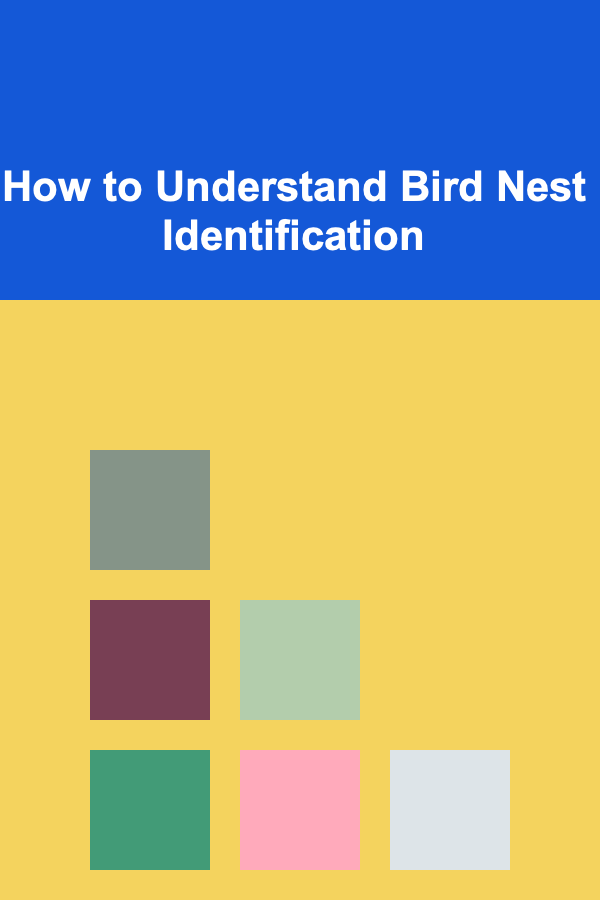
How to Understand Bird Nest Identification
ebook include PDF & Audio bundle (Micro Guide)
$12.99$10.99
Limited Time Offer! Order within the next:

Identifying bird nests is a fascinating yet often overlooked aspect of birdwatching and ornithology. The ability to recognize different types of bird nests not only enhances the birdwatching experience but also provides valuable insights into the reproductive behaviors, habitats, and ecological roles of various bird species. For those who are passionate about birds, understanding how to identify their nests can be just as rewarding as identifying the birds themselves. This article delves into the importance of bird nest identification, the various types of bird nests, and the methods used to identify them.
The Importance of Bird Nest Identification
Bird nests are vital to the survival and reproduction of birds. They serve multiple functions, such as providing a safe environment for eggs, offering protection from predators, and keeping young birds warm. Identifying bird nests gives us insight into the species that inhabit a particular area and can even offer clues about the environment itself.
By understanding the nests of different birds, birdwatchers and researchers can:
- Track bird populations: Recognizing nests helps ornithologists monitor breeding success and population trends.
- Protect birds: Knowing where birds nest allows for the creation of protected areas to safeguard vulnerable species.
- Improve conservation efforts: Identifying critical nesting sites can inform conservation practices and habitat management.
- Learn about bird behavior: Different birds have unique nesting habits, and studying nests can provide valuable information about their reproductive strategies, feeding behaviors, and territoriality.
Additionally, knowing how to identify bird nests can be an enjoyable and educational pursuit for nature enthusiasts. It encourages careful observation and deepens the appreciation of birdlife.
Types of Bird Nests
Birds exhibit a wide variety of nesting behaviors, and their nests come in different shapes, sizes, and locations. Broadly speaking, bird nests can be categorized into several types based on their construction materials, placement, and structure. Let's take a closer look at these categories.
1. Cup Nests
Cup nests are perhaps the most familiar type of bird nest. These nests are shaped like small cups or bowls, often built to hold eggs securely while providing a comfortable space for the young birds once they hatch. Cup nests are usually constructed from twigs, grass, moss, feathers, and sometimes even spider silk.
Key Features:
- Shape: Circular or bowl-shaped, with a deep interior to hold eggs and chicks.
- Materials: Twigs, grasses, moss, and feathers.
- Location: Commonly found in trees, shrubs, or sometimes on the ground.
Species: Many songbirds, such as sparrows, robins, and warblers, build cup nests. These nests are usually positioned in the forks of trees or branches, sometimes in bushes or even on the ground, depending on the species.
2. Cavity Nests
Cavity nests are built inside natural cavities, such as tree hollows, or artificial cavities like nest boxes. These nests are often more protected from predators and harsh weather than cup nests. Birds that build cavity nests tend to be more secretive, nesting in places that are difficult to reach.
Key Features:
- Shape: Often irregular and less defined compared to cup nests.
- Materials: Dead leaves, wood chips, feathers, and sometimes even bits of bark.
- Location: Inside tree cavities, old buildings, or man-made nest boxes.
Species: Woodpeckers, owls, and some species of ducks and tits are known to use cavity nests. These birds tend to nest in areas with large, mature trees or buildings that provide suitable cavities.
3. Platform Nests
Platform nests are large, flat structures built by larger birds such as eagles, hawks, and herons. These nests are usually made from sticks and other large materials and can be quite robust. The platform shape allows the birds to have a stable and safe area to lay their eggs.
Key Features:
- Shape: Flat or slightly bowl-shaped, often large and sturdy.
- Materials: Twigs, sticks, and other large materials.
- Location: High in trees, often in the tallest branches.
Species: Birds of prey, such as eagles, hawks, and osprey, are known for building platform nests. These nests are often in tall trees or cliff sides, providing the birds with an elevated and safe location to protect their young.
4. Ground Nests
Ground nests are built directly on the ground, typically in tall grasses, underbrush, or forest floors. These nests can be vulnerable to predators, and the birds that build them must carefully choose locations that offer some degree of cover and protection.
Key Features:
- Shape: Simple depressions or shallow cups.
- Materials: Grass, leaves, twigs, and sometimes moss.
- Location: Hidden under vegetation, in fields, grasslands, or forests.
Species: Many ground-nesting birds, such as quail, pheasants, plovers, and some waterfowl, build their nests on the ground. These birds are typically more camouflaged and rely on their ability to remain hidden to protect their eggs and chicks.
5. Hanging Nests
Hanging nests are constructed by birds that create intricate nests suspended from tree branches, sometimes even from grass stalks. These nests are often woven tightly and hang like a basket or pouch.
Key Features:
- Shape: Hanging or suspended, often pouch-like.
- Materials: Grass, leaves, and twigs, with fine threads or fibers.
- Location: Suspended from tree branches, reeds, or grass stalks.
Species: Weaver birds, particularly those in the family Ploceidae, are known for their elaborate hanging nests. These nests are often built in dense colonies and are intricately woven to create secure homes for their eggs and chicks.
6. Mud Nests
Mud nests are constructed using mud or clay, often built into crevices or on man-made structures. These nests are solid and durable, offering a unique form of protection against environmental elements.
Key Features:
- Shape: Cup-shaped or cylindrical.
- Materials: Mud or clay mixed with grass, feathers, and plant fibers.
- Location: On cliff faces, buildings, or bridges.
Species: Swallows and other species of the family Hirundinidae are known for constructing mud nests. These birds often build their nests on vertical surfaces such as building eaves, cliffs, or bridges.
7. Artificial Nests
With the rise of human activity and urban environments, some birds have adapted to nesting in man-made structures. These artificial nests can be found in locations such as rooftops, balconies, and even vents.
Key Features:
- Shape: Varied, but often modified to fit the available space.
- Materials: Includes a mix of natural materials as well as human-made debris like paper, plastic, or string.
- Location: Urban or suburban environments, often in or around human structures.
Species: Pigeons, sparrows, and swallows are common birds that adapt to human-built environments for nesting.
Methods of Bird Nest Identification
Identifying bird nests requires patience, observation, and sometimes a little bit of detective work. The key to successful bird nest identification lies in recognizing the specific characteristics of the nest, such as materials, shape, location, and any markings or clues that might indicate the species that built it. Here are some methods to help identify bird nests effectively:
1. Observe the Nest's Location
The location of a nest is often one of the most telling factors in identifying the species that built it. Different birds prefer specific nesting sites, and recognizing these preferences can significantly narrow down the possibilities.
- Trees: Many birds, especially songbirds and raptors, build nests in trees. Look for nests in the canopy or forks of branches.
- Ground: Ground-nesting birds, like plovers or ducks, often place their nests in concealed spots like tall grasses or shrubs.
- Cavities: Birds that nest in cavities, like woodpeckers or owls, will use hollow trees or buildings.
- Man-Made Structures: Birds like pigeons, swallows, and sparrows often use man-made structures such as buildings, bridges, and streetlights.
2. Study the Nest's Materials
Birds often use materials that are readily available in their environment, and these materials can be a significant clue to identifying the bird species. Pay attention to the following:
- Feathers: Some birds, like songbirds, use feathers to line their nests for warmth.
- Twigs and Branches: Larger birds like eagles and crows often use sticks and twigs to build platform nests.
- Mud or Clay: Swallows and martins are known for building nests made of mud.
- Grass and Plant Material: Smaller songbirds like warblers and sparrows often use grasses and plant fibers to build their nests.
3. Examine the Shape and Size
The shape and size of a nest are critical factors in identification. Some nests are large and bulky (e.g., platform nests), while others are small and delicate (e.g., cup nests). The size of the nest can also help in identifying the bird species---larger birds tend to build larger nests.
4. Look for Eggs or Young Birds
If you're able to safely observe a nest during the breeding season, you may be able to see the eggs or young birds inside. Egg color and pattern, as well as the appearance of the chicks, can offer additional clues. Many birdwatching resources and guides include photographs of bird eggs, making this a helpful identification method.
5. Consider Seasonal Timing
Birds typically build their nests in the spring or early summer, with nesting behavior peaking in these months. The timing of when a nest is being built can provide clues about the species, as some birds, such as swallows, may migrate or nest earlier than others.
6. Take Care with Disturbing Nests
It's important to remember that bird nests are often protected by law in many countries, so disturbing them can be illegal. Always observe nests from a safe distance to avoid causing any harm to the birds or their eggs.
Conclusion
Understanding bird nest identification is an essential skill for anyone passionate about birds and wildlife. By learning to recognize the different types of nests and the specific characteristics that can help identify them, birdwatchers and researchers gain deeper insights into bird behaviors, ecological roles, and conservation needs. Whether you're an experienced ornithologist or a beginner birdwatcher, studying bird nests adds an enriching layer to your birding experience, helping you connect with nature in a meaningful way. Through careful observation and respect for these creatures, we can better protect and appreciate the incredible diversity of birds in our world.

How to Organize Vintage Art Supplies for Creative Projects
Read More
How to Organize Your Kids' Clothes by Season
Read More
How To Understand Network Protocols for Web Development
Read More
How to Summarize Texts in Your Target Language
Read More
How To Make Your Own Gifts and Cards: A Creative and Personalized Guide
Read More
How to Conduct a Talent Acquisition Plan Audit and Improve Results
Read MoreOther Products

How to Organize Vintage Art Supplies for Creative Projects
Read More
How to Organize Your Kids' Clothes by Season
Read More
How To Understand Network Protocols for Web Development
Read More
How to Summarize Texts in Your Target Language
Read More
How To Make Your Own Gifts and Cards: A Creative and Personalized Guide
Read More